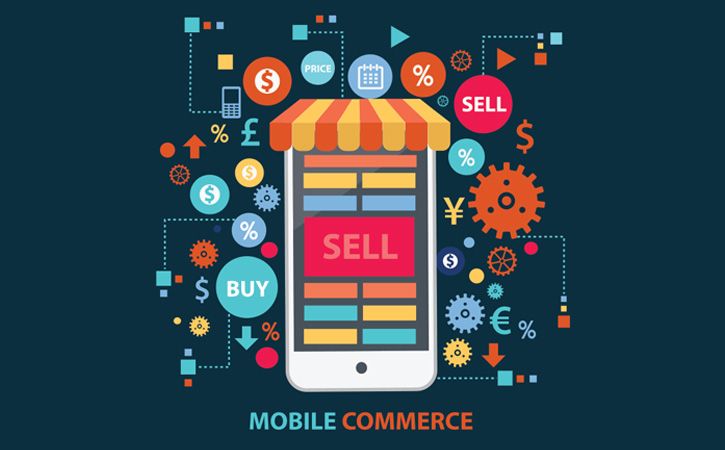M-commerce, or mobile commerce, has become a convenient and popular method of buying and selling goods and services, especially with the widespread availability of smartphones and tablets. With this growing trend, it is crucial to have a secure M-commerce application to ensure that sensitive customer data, such as financial information, is protected.
In this blog, we will explore the importance of security in M-commerce, the steps involved in developing a secure M-commerce application, and the strategies used to secure an app.
What Do Data Show About the Growth of the M-commerce Market?
According to Statista, the global mobile commerce market size is expected to reach 3.5 trillion US dollars by 2021. More and more people are using their mobile devices to shop, pay bills, and transfer funds. However, with this growth, the vulnerability of mobile commerce applications also increases.
Why Security Is Important for Your Mobile Commerce Business?
Security is important for several reasons, but most importantly, it protects the business and its customers from cyber attacks. If sensitive information, such as credit card details, is not protected, then the consequences can be disastrous for the business, leading to reputational damage, loss of revenue, and legal liabilities. In addition, ensuring the security of your M-commerce app can increase customer trust, leading to more loyalty and more business.
How are Mobile Commerce Applications Developed?
Mobile commerce applications are developed in a series of steps, usually involving the following:
Step 1: Requirement Analysis – Analyzing customer requirements before developing the M-commerce app and identifying potential security threats.
Step 2: Architecture – Designing the overall structure of the app and identifying security measures, such as encryption, that need to be implemented.
Step 3: Coding and Development – Developing the M-commerce app using programming languages such as Java, Swift, and C++, and implementing security features such as authentication and encryption.
Step 4: Testing and Deployment – Testing the application to ensure its functionality and security are up to standard, then deploying it to production to be used by customers.
Step 5: Maintenance and Updates – Regularly maintaining and updating the app to patch any vulnerabilities that may arise, and keeping up with the latest security best practices.
How to Secure Your M-Commerce App?
Now that we have a basic understanding of the M-commerce app development process, let’s explore some of the steps you should take to ensure your app is secure:
Review the Codes
One of the most important steps in ensuring the security of your M-commerce app is conducting a thorough review of the source code. This will help to identify any potential vulnerabilities that could be exploited by hackers. This step involves scanning the code for weaknesses using a variety of tools such as static code analysis, manual code reviews, and automated testing software.
Regular Authentication
Ensuring regular authentication is key to keeping your M-commerce app secure. This means implementing verified login features such as biometric scans, two-factor authentication, or multi-factor authentication on the app’s login page. This will keep unauthorized users from accessing the app’s sensitive information.
Cryptography
Encryption is one of the most important tools to use when building an M-commerce app, and incorporating cryptography into your app’s design should be a priority. The data stored on your app’s servers, as well as the data that is transmitted between servers and users, should be encrypted with strong encryption algorithms such as AES and RSA. This will protect your app’s sensitive data from harmful cyber-attacks.
Binary Protection
Binary protection is a security mechanism that prevents attackers from reverse-engineering your app and extracting sensitive data or intellectual property. To prevent such attempts, measures such as code obfuscation, hiding the app’s source code, and setting up secure barriers are often used in secure M-commerce app development.
Patch Constantly
M-commerce apps should be updated regularly to address any security vulnerabilities and new threats. This also includes patching new releases from third-party libraries and APIs that the app uses. By constantly patching your M-commerce app, you enhance its security and reduce the risk of successful cyber-attacks.
Prevent Injection Attacks
Preventing injection attacks is a critical step in securing your M-commerce app. Injection attacks occur when an attacker inputs malicious code into a form or other input field, exploiting any vulnerability in the backend system to gain access or steal data. By implementing security measures like parameterized input validation and using prepared statements, you can prevent this type of cyber-attack.
Update your Libraries
M-commerce apps are often built using open-source libraries and APIs, making them vulnerable to security threats. It is important to keep an eye on any new updates and security patches that the library developers release. Checking for updates and installing them as soon as possible should be a standard practice in your app’s development process.
Additional Security Features to Take into Account for Your M-commerce App
In recent years, mobile commerce has grown rapidly and has become one of the most popular ways people purchase products and services. However, with the increasing use of mobile devices for e-commerce, the threat to cyber security has also increased. Therefore, it is of utmost importance for businesses to prioritize security features when developing m-commerce apps to ensure the safety and protection of their customers.
In this blog post, we will discuss the additional security features that should be considered when developing an m-commerce app. We will also cover the top features of an m-commerce app and the future of mobile commerce app development.
User Experience (UX)
User experience plays a crucial role in the success of an m-commerce app. It is important to prioritize a user-friendly interface that allows for seamless navigation and clear-cut information. However, it is equally important to integrate top-notch security features to ensure the safety of the users’ data.
One way to enhance UX for m-commerce apps is by providing fast log-in options. Users should be able to access their accounts through a one-touch login process, or through biometric authentication like fingerprint or facial recognition. Additionally, it’s also important to provide multi-factor authentication for transactions, such as the use of SMS verification or security questions.
Legal Compliances
M-commerce apps must comply with laws and regulations set by regulatory bodies like the Payment Card Industry Data Security Standard (PCI DSS), General Data Protection Regulation (GDPR), and other general data protection laws.
Businesses must take necessary measures to comply with governmental regulations, laws, or industry-specific requirements to avoid data breaches or cyber attacks. This helps to protect the users’ personal data and also the credibility of the business.
Top Features of an M-commerce App
1. A product Gallery
The main objective of an m-commerce app is for users to shop for products online, so it’s crucial to have a product gallery that’s both visually appealing and easy to navigate. Each product listing should come with a detailed description, user reviews, and product images.
2. Personalization
Mobile commerce apps should provide the option to personalize the shopping experience for users. This can be achieved by keeping the user’s search history and suggesting similar products or offering recommendations based on their previous purchases. This also helps to form long-term loyalty and enhance customer retention.
3. Order Tracking
Order tracking is an important feature that helps users to keep track of their orders and stay informed of its progress. With every successful order placed on the app, customers should receive a confirmation email detailing their order, the estimated delivery time and a tracking number that can be used to track shipment progress.
4. Elimination of Crashes and Bugs
Mobile commerce apps should be rigorously tested and optimized for the best performance. Bugs and crashes can compromise the data security and the overall user experience, making it less appealing for users to return to the app. It’s important for businesses to hire experienced and reliable developers who are proficient in creating mobile apps with improved user functionality.
5. Analytics
An app that’s not optimized won’t help businesses to achieve its desired targets. Analytics tells businesses how the app is performing in terms of engagement, peak hours, goals conversion, and other important metrics that are useful in monitoring business performance. Analytics is crucial for measuring rate of conversion and app engagement, leading to more effective decision-making necessary for improved user experience.
6. Search Bar
The search bar helps customers to navigate through the app and find specific items they’re looking for quickly and effectively.
7. Modes of Payment
Offering users a wide variety of payment methods will enhance the customer experience and boost the likelihood of successful transactions. For example, allowing customers to pay with different payment methods like PayPal, credit cards, Apple Pay, or Google Pay will make payments convenient, safe, and hassle-free.
8. An Offer Section
The offer section is a great tool for promoting products, as it allows businesses to highlight different products with discounted or seasonal rates. This section can be customized to display constantly changing promotions and trending products.
9. Customer Service
The customer service feature allows customers to get their questions answered and issues resolved efficiently. An effective customer service team always serves to enhance the user experience, leaving a positive impact on the user and promoting long-term customer satisfaction.
Development of Mobile Commerce Apps in the Future:
In the future, mobile commerce apps will continue to gain momentum due to the ease of access and user-friendly interface. Consumers will continue to purchase products through mobile commerce platforms, and retailers will need to optimize m-commerce apps to remain competitive.
Businesses must stay up-to-date with the latest trends and technologies in app development, especially those relating to security features. They must comply with the laws and regulations set by cyber security bodies that will improve the safety and security of the user while using the app.
Conclusion
In today’s modern world where mobile commerce apps have become an essential part of people’s lives, the need for additional security features cannot be ignored. The wide-ranging benefits of implementing advanced security measures for such apps can protect sensitive customer information, minimize the risk of fraud, enhance customer loyalty, and ultimately increase revenue. Taking into account the growing concerns for online security, it is essential for businesses to prioritize their Mcommerce app security and invest in the latest technology to establish a foolproof security system. By implementing additional security features, businesses can build trust among their customers and create a safer and more secure online shopping experience, leading to greater customer satisfaction and long-term profitability.







